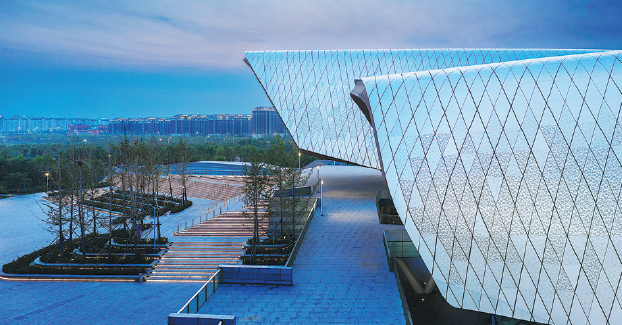New venue showcases marine heritage


Tianjin museum design encourages exploration, discovery
Just outside the northern port city of Tianjin sits the latest addition to China's cultural heritage.
The National Maritime Museum of China is an imposing modern complex designed by the Australian company Cox Architecture and the Tianjin Architecture Design Institute, or TADI.
The museum joins a growing list of innovative, modern architecture across China – from Beijing Daxing International Airport, to the country's focus on "green" design in urban development.
Since the museum's soft opening in May, thousands have flocked to an institution that will highlight China's maritime history. No date has been announced for the official opening.
Philip Cox, whose company won the international design competition for the project in 2012, said the elegant, simple layout of the museum, which sits on a manmade bay, features white exhibition halls stretching out like the fingers of a hand, resembling brush strokes in calligraphy.
Liu Jingliang, honorary president of TADI, the local design partner for the project, said, "The main aim of the museum is to enhance people's awareness of the sea.
"As President Xi Jinping said during the military parade to mark the 70th anniversary of the founding of the People's Liberation Army Navy, 'The blue planet humans inhabit is not divided into islands by the oceans, but is connected by the oceans to form a community with a shared future'."
Liu said that China now has its first such national museum "and we are very proud to have participated in this project".
He said the world-class building combines elements of history, culture and art.
Covering 80,000 square meters, the building's four halls stretch out over the harbor and converge onto a central area.
Each hall is devoted to a different aspects of the country's marine heritage: nature and oceans; world maritime civilization; marine culture; and historic vessels. There is a temporary exhibition hall and space for public education, business, research and curatorial facilities.
This arrangement of the halls and the maritime plaza ensured the museum does not resemble one huge building.
The architecture is informed by aquatic references, such as anemones, coral and vessels in port — subtle enticements to explore its exhibits.
The design leads visitors up a ramp to an elevated area from which they can access one of two split levels, allowing the collections and operations center to be located immediately under the main hall.
Liu said the design adopted "a nonlinear approach extending from the land to the sea, with the land and water interacting with each other".
"This will encourage people to explore and discover (the building) themselves. While some say the exterior looks like a shoal of fish jumping toward the surface of the sea, others think it is like a boat lying on the sea, or a hand reaching toward the sea. Some even say it depicts various creatures under the water."


















